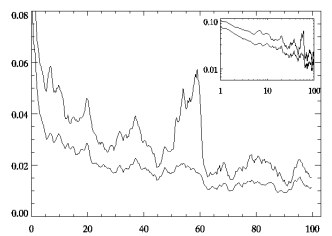
RELEVANT PUBLICATIONS:
|
Like atomic glasses, colloidal systems also undergo a glass transition. But instead of lowering temperature to make a glass, we raise the particle density. Our colloids naturally want to form crystals, so to knock the system out of equilibrium and make a colloidal glass, we concentrate the colloid faster than it can crystallize. The result is a very dense and viscous suspension with particles distributed randomly. Ideally, a colloidal glass will never crystallize.
|
|
Most experimental studies of aging involve dynamic light scattering, which typically involves large ensemble averages. With a fast scanning confocal microscope, we are able to see and track individual colloidal particles, such as those shown above. We can explore the dynamics and the structure of the glass in a much more local environment. Aging dynamicsWhen we began this project, we found that the dynamics of colloidal glasses slow
down with age. The plot below shows the relaxation of the mean square displacement
(MSD) of the particles in a sample over the course of an hour. The data is divided
into temporal chunks to generate each curve in the plot. The top curve (red) in the
graph displays the dynamics of the sample right after it has been initialized. The
last curve (black) displays particle dynamics at around one hour of aging.
As you can see, there is a marked relaxation in particle dynamics. Individual glassy MSD curves look about the same as those of colloids in the super-cooled liquid regime -- in each, the MSD curve has three components. At short time scales (low dt), the particles are not aware of their neighbors and their behavior is diffusive, with <x2 + y2> = 4Dt. At intermediate time scales, there is a plateau that corresponds to the trapping of particles by their neighbors. For glass samples, this plateau extends to longer and longer time scales as the sample ages. The upturn at long time scales is a bit of a mystery. It is commonly held that the upturn corresponds to groups of particles that are mobile because they are able to move cooperatively. Interestingly, we found that glasses do not age uniformly. The dynamics slow down overall as the sample ages, but not at a steady rate. This temporal heterogeneity can be seen very easily in MSD when the data is less roughly divided than in the above plot. |
| We can also see heterogeneous relaxation in the dynamics by picking a delay time (dt), calculating how far particles move over that time interval, and plotting this average mobility as a function of the sample age. The bottom curve in plot to the right shows mobility for dt = 10 minutes. As you can see, this relaxation does not occur smoothly. As the glass ages, the average mobility of the particles can actually increase! |

(lower curve) |
|
The upper, related, curve is a measure of how many particles are
conspicuously mobile. As you can see, the proportion of mobile particles relaxes, too, and it is
well correlated with the mobility (lower curve). This behavior seems to suggest the existence of aging
"events." We see this behavior over a large range of delay times. The inset in the above figure shows
both curves on a log-log plot. You may be interested in reading our papers for a more full discussion. See the list at the top of this page. Subsequent experimentsThe colloidal glasses we first studied were monodisperse (i.e. one size) colloidal suspensions. We later (~2007-08) investigated aging in binary mixtures. |
A primer on colloidal glass can be found here.
This work was primarily funded by NASA (NAG3-2728). For more information, please contact Eric Weeks: <erweeks(at)emory.edu>